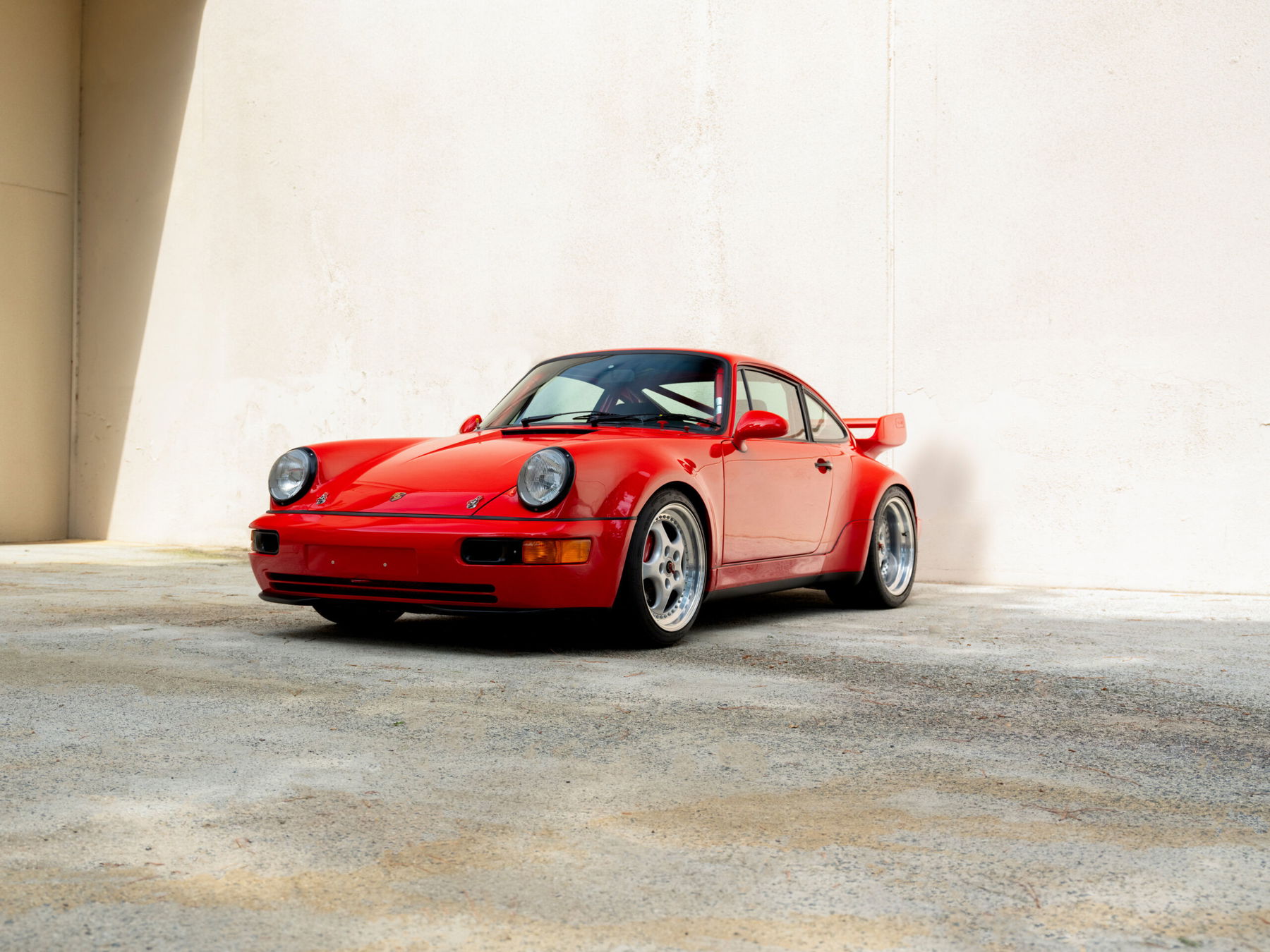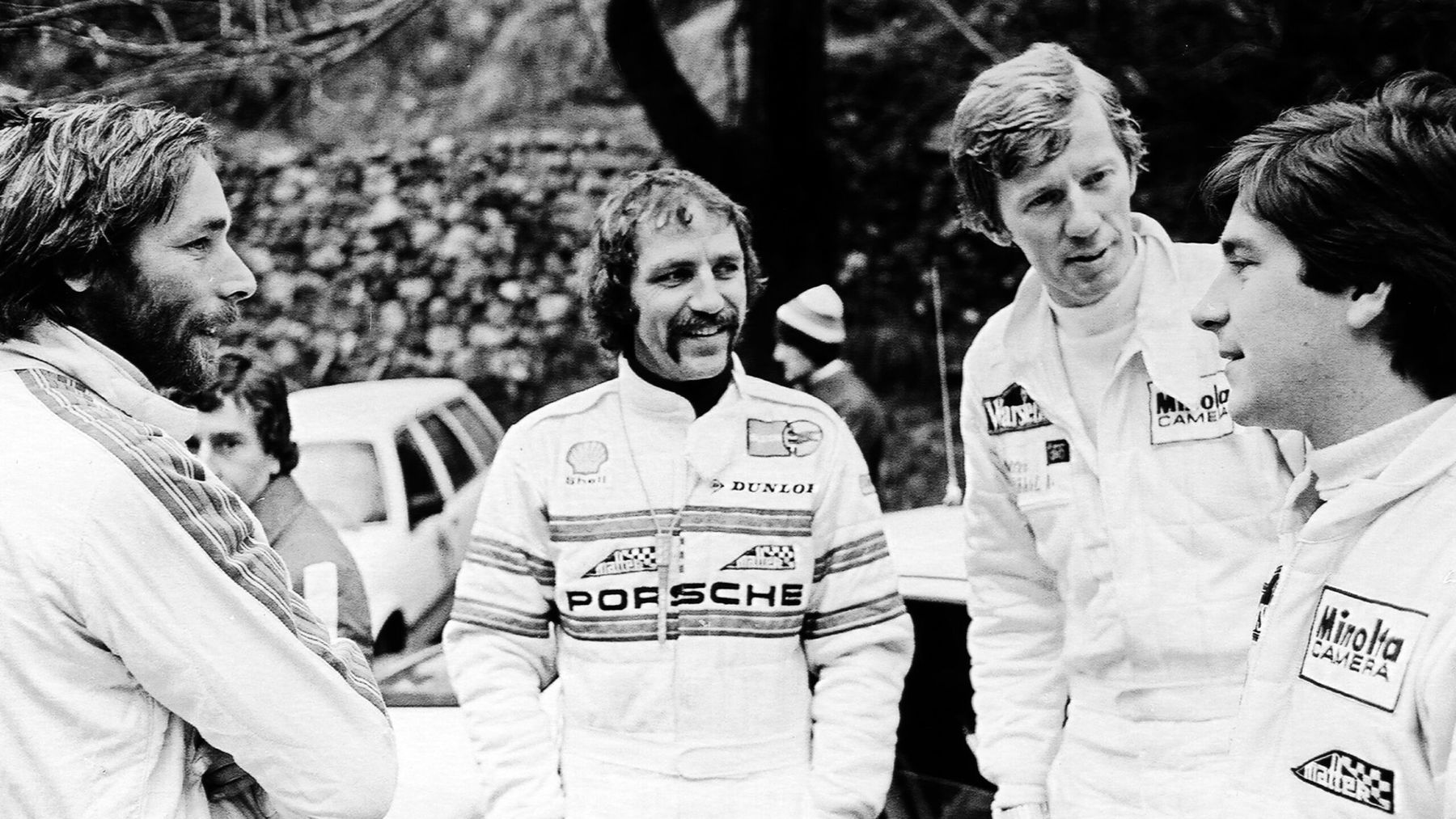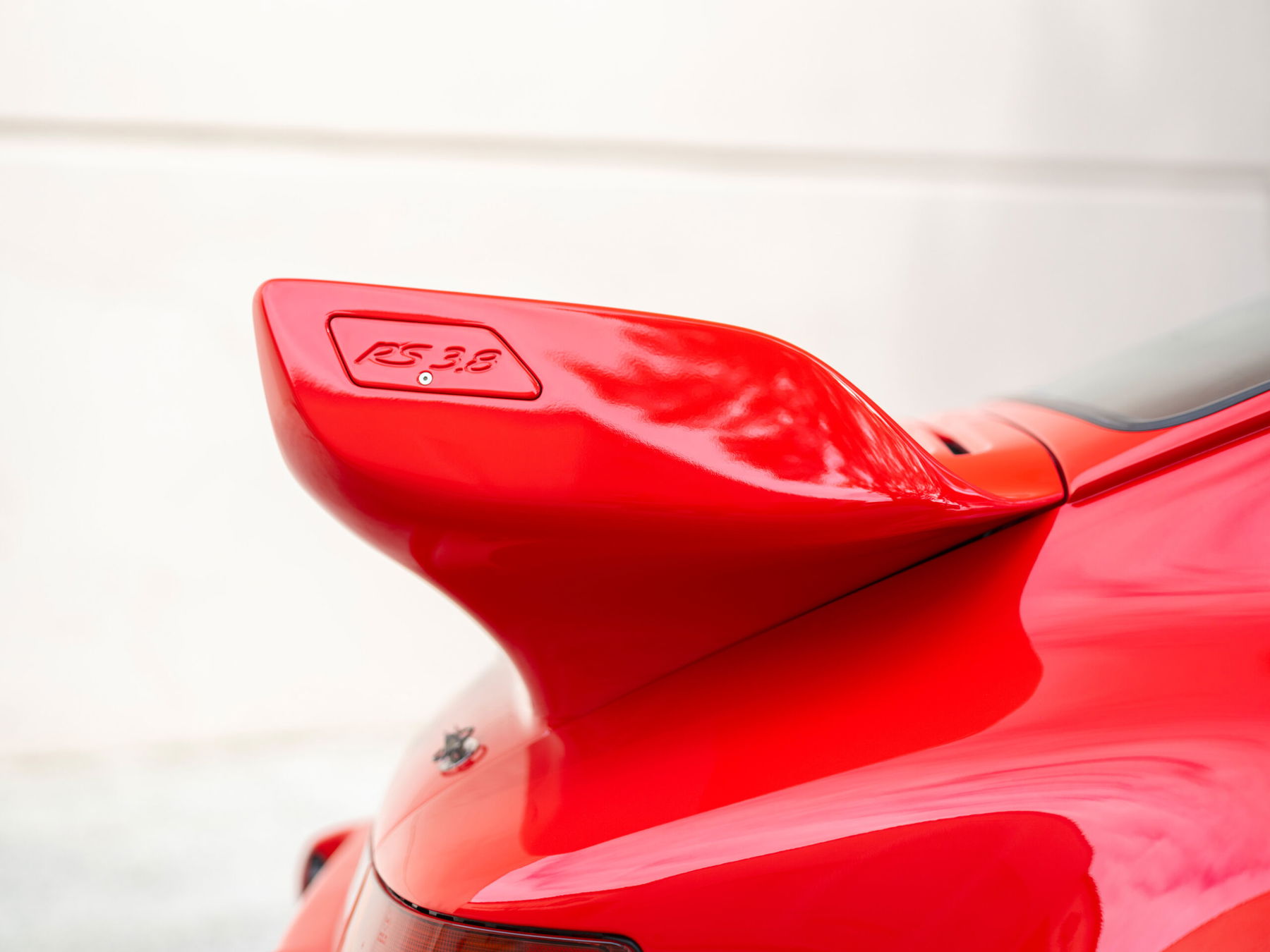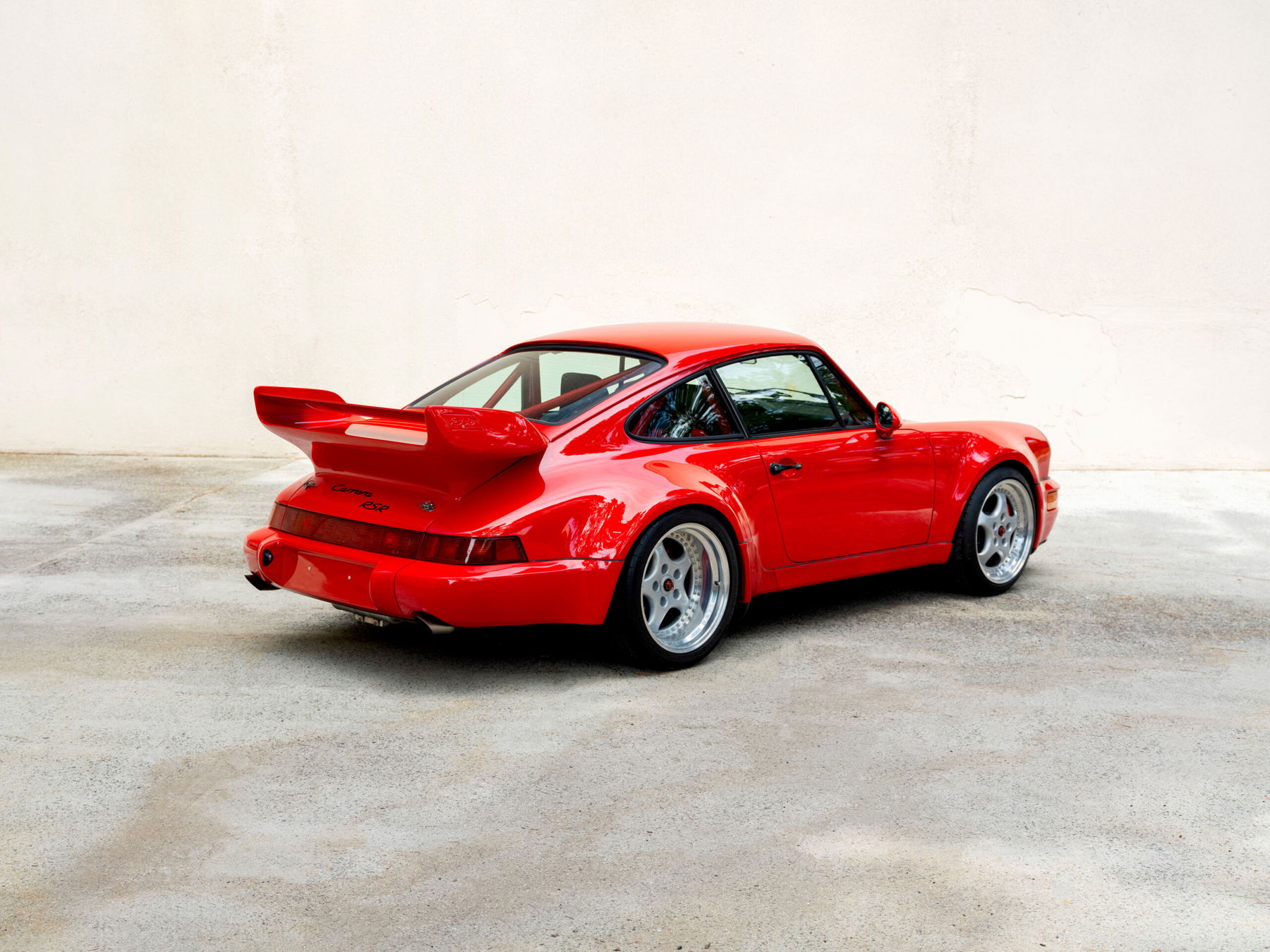
Historic racing cars have their very own charm. They show what was technically possible in the respective era, often sport wild paintwork and proudly display battle scars from racing. The Porsche 964 Carrera RSR 3.8 occupies a very special place in all this. In 1993, the year of the Porsche 911’s 30th birthday, four RSR 3.8s took the first four places in the 24-hour race at the Nürburgring. It was also the first Porsche 911 to compete in the 24 Hours of Le Mans since 1984. There, too, the first four places in the newly created GT class went to the RSR. In 2024, one of only 51 RSRs is up for sale. At RM Sotheby’s Monterey Auction, the Porsche 964 Carrera RSR 3.8 number 496090, the example with probably the lowest mileage ever, will go under the hammer. Reason enough to take a closer look at the RSR’s history.
Porsche was extremely successful in the sports car world championship of the 1980s. The 956 and 962 Group C racing cars, used by numerous customer teams, sold almost 120 units alone. However, with the end of this championship in 1992, Porsche’s motorsport department was virtually out of work. At the same time, there was a direct correlation between the sale of racing cars and the sales figures for production vehicles. “When the line depicting race success dropped, the sales figures did almost exactly the same on year later. When Porsche won again, the sales increased. The two lines on the chart followed each other”, reported then head of Porsche’s customer sport program, Jürgen Barth.
In order to sell road-going sports cars, we need success in racing.
Jürgen Barth
In the excellently researched book “Porsche 964 Carrera RS 3.8”, Barth answered the question about Porsche’s future in sport as follows: “We are in a really tricky position when it comes to our engagement in motorsport. At the moment it actually works perfectly with our Carrera Cup and Porsche Supercup programmes, but in the future that won’t be enough. Just like in the past, we have to return to bigger, multi-brand categories, as we are a sports car manufacturer. In order to sell road-going sports cars, we need success in racing.”

After the end of the sports car world championship, Porsche had to find new ways to be successful in racing. Ideally in a motorsport class with production-based vehicles. For many years, Jürgen Barth therefore campaigned for the reintroduction of the GT category on a global stage. Together with numerous manufacturers, including Nissan and Honda, Barth drew up regulations that were approved by the international motorsport authorities in 1993.
The much wider fenders and additional air intakes in the front make the Porsche 964 Carrera RSR 3.8 look much more aggressive than the 964 Carrera RS.
Of course, Porsche’s motorsport department had already done the groundwork. Although the 964 had theoretically been fully developed at the time, the Executive Board around Arno Bohm and Ulrich Bez gave their blessing to the Porsche 964 Carrera RS/RSR 3.8 project as early as 1992. At least 50 road cars and 50 racing cars were planned in order to meet the FIA homologation requirements. The technical project manager Roland Kussmaul explained: “[…] the target was to bring as much racing technology as possible already into the RS 3.8 road car and therefore be best-prepared for having the RSR 3.8 race-ready”. This was to give the RSR 3.8 the best possible starting point.
Porsche’s design recipe for the 964 Carrera RSR 3.8 was simple yet catchy. In the company’s own vehicle description, under the heading Bodywork, the first line reads: “Same as Turbo”. Added to this was the now legendary rear wing, aluminum doors and front hood, the beautiful 18-inch Speedline wheels and a 43-liter racing tank for the ADAC Cup and 120 liters for endurance racing. Inside, bucket seats with six-point harnesses and a roll cage were a matter of course. As the last Porsche racing car with the large torpedo fenders, it has long been an icon. Many 964 conversions are based on its styling.
While the chassis panels on regular Porsche 964 models were only spot-welded, the 964 Carrera RSR received continuous weld seams to increase its rigidity.
On the engine side, the changes in comparison to the Carrera or Carrera RS were also significant. A new crankcase with a two millimeter larger cylinder bore was used in the Porsche 964 Carrera RS/RSR 3.8. This increased the displacement to 3,746 cc. Despite the larger diameter, the pistons were lighter than in the 3.6 liter engine. A completely new intake system with individual throttle bodies and sequential fuel injection, combined with the newly designed exhaust system, enabled significant leaps in performance. The Carrera RS 3.8 road model already had 300 hp. According to conservative factory specifications, the RSR’s racing engine delivered up to 350 hp in Le Mans specification.




The RSR’s potential was already evident in its first outings. Although Porsche had not yet completed all the cars for the 1993 24 Hours of Le Mans test, the 964 Carrera RSR 3.8 was an immediate hit. In its first year, it won all the major endurance races of the season with a class victory in the 24 Hours of Le Mans, as well as overall victories in the 24 Hours of Nürburgring and the 24 Hours of Spa.
The Porsche 964 Carrera RSR 3.8 with chassis number WP0ZZZ96ZPS496090 now on offer at RM Sotheby’s Monterey Auction is special in many respects. It starts with the choice of color. Apart from one prototype, there were only two other RSRs that were painted Guards Red. #496090 is one of them. The other Guards Red RSR competed in numerous races in the USA from 1994 to 1998 and bore the number 496095.
With the exception of a new FIA-certified fuel tank, the entire RSR 3.8 is in original condition.
RSR #496090 was built to endurance specification. This means that the Porsche 964 Carrera RSR 3.8 was equipped with the “Le Mans” specification engine, a 120 liter fuel tank and a transmission set-up for a top speed of up to 300 kph. It was ordered by a certain Mr. Walter Scheuermann from Memmingen, who reportedly ordered several RS and RSR 3.8s.
Walter Scheuermann had good contacts in Japan. He sold the Porsche Carrera RSR 3.8 number 496090 there, where the rare racing car had been part of a collection for almost two decades. In 2013, the car traveled to the USA and has remained with its current owner ever since. It has never been used on a race track. Instead, the RSR still shines today in new car condition. Its speedometer shows just 39 (!) kilometers. Alongside a Porsche 964 Turbo S Leichtbau and a 959 prototype, it is therefore certainly one of the most exciting Porsche exhibits at the RM Sotheby’s Monterey Auction on August 16 and 17, 2024.




A car more than three decades old in new condition is a sensation in itself. Jürgen Barth assumes that this is the 964 RSR with the lowest mileage ever. But it is not just a rolling time capsule. Thanks to an extensive service for around 40,000 US dollars, it is ready to drive and even road-legal! It has a regular American title and registration.
The Porsche 964 Carrera RSR with chassis number WP0ZZZ96ZPS496090 on offer at RM Sotheby’s is the road-legal version of a Le Mans class winner!
Its estimated price is correspondingly high. The experts at RM Sotheby’s estimate between 1.25 and 1.5 million US dollars. Will the future owner of what is probably the only remaining Porsche 964 Carrera RSR 3.8 in like-new condition actually use it on the road? Even if we are big fans of using these cars for their intended purpose, this RSR is probably too important a testimony to motorsport history.
Either way, just looking at it makes your jaw drop. Interior, paintwork, engine compartment, wheels… everything shines like new. The only indication of the vehicle’s advanced age is a bit of aluminum oxidation of the Bosch Motronic housing. Apart from that, this RSR is probably the last opportunity to recreate the feeling of a new air-cooled racing car being delivered from the factory. Such an opportunity is rare. We’ll be keeping a close eye on where the highest bid at the Monterey auction ends up.
© images: Matthew Jones, RM Sotheby’s
Elferspot magazine